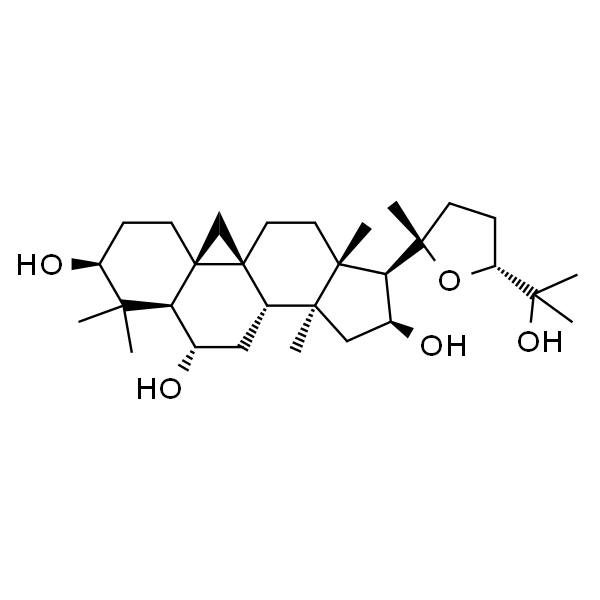| CAS |
84605-18-5 |
| Chinese Name |
环黄芪醇 |
| English Name |
Cycloastragenol |
| Synonyms |
Cyclogalegigenin;Astramembrangenin |
| Molecular Formula |
C30H50O5 |
| Molecular Weight |
490.72 |
| Solubility |
Soluble in DMSO |
| Purity |
HPLC≥98% |
| Appearance |
White to off-white Solid |
| Storage |
Powder:2-8℃,2 years;Insolvent(Mother Liquid):-20℃,6 months;-80℃,1 year |
| MDL |
MFCD00001124 |
| SMILES |
O[C@H]1CC[C@@]2(C3)[C@]([C@@H](O)C[C@]4([H])[C@@]23CC[C@@]5(C)[C@@]4(C)C[C@H](O)[C@]5([H])[C@@]6(C)O[C@@H](C(C)(C)O)CC6)([H])C1(C)C |
| Target Point |
Telomerase |
| Passage |
Cell Cycle;DNA Damage/DNA Repair |
| Background |
Cycloastradiol is a tetracyclic triterpenoid. |
| Biological Activity |
Cycloastragenol (CAG, TA-65, Cyclogalegigenin, Astramembrangenin) is a saponin comprising a group of oil glucosides naturally present in a number of plants. It is a potent telomerase activator in neuronal cells.[1-2] |
| In Vitro |
Cycloastragenol stimulates telomerase activity and cell proliferation in human neonatal keratinocytes. It induces telomerase activity and cAMP response element binding(CREB)activation in PC12 cells and primary neurons. CAG treatment not only induces the expression of bcl2,a CREB-regulated gene,but also the expression of telomerase reverse transcriptase in primary cortical neurons[1]. Cycloastragenol rapidly passes through the Caco-2 cell monolayer by passive diffusion,once passage through the intestinal epithelium,first-pass intestinal metabolism of Cycloastragenol might occur. Cycloastragenol can undergo extensive metabolism in rat and human liver microsomes[2]. |
| In Vivo |
Oral administration of cycloastragenol(CA)for 7 days attenuates depression-like behavior in experimental mice. Oral bioavailability of cycloastragenol is about 25.70% at 10 mg/kg. Cycloastragenol is excreted through bile and feces and eliminated predominantly by the kidney in rats. It also might exist an enterohepatic circulation of cycloastragenol in rats. Cycloastragenol could be metabolized widely in vivo in rat. For oral administration the mean Tmax at 10 mg/kg,20 mg/kg,and 40 mg/kg is 2.06±0.58 h,1.48±0.36 h,and 2.35± 1.17 h. The t1/2 is 5.23±1.55 h,7.33±3.03 h,and 6.06± 3.42 h,respectively. The mean absorption time of CA at 10 mg/kg is 5.70± 1.62 h; the poor absorption could be caused by the low solubility. The pharmacokinetic parameters show no significant differences among the groups of 10,20,and 40 mg/kg except for Cmax and AUC[2]. |
| Cell Experiment |
HEKn cells(population doubling time: 3-6 days),PC12 cells(passage No.: 12-18),cultured primary cortical,and hippocampal neurons [12 days in vitro(DIV)] are treated with CAG for 24 h. Total cell lysates are then collected by using the lysis buffer provided in the real-time quantitative telomeric repeat amplification protocol(RQ-TRAP)assay kit. Telomerase activity is determined by using an ABI Prism 7000.[1] |
| Animal Experiment |
Animal Models: male ICR mice; Dosages: 100 mg/kg; Administration: by oral gavage[1] |
| Data Literature Source |
[1] Ip FC,et al. Neurosignals. 2014,22(1):52-63.
[2] Ma PK,et al. Xenobiotica. 2017,47(6):526-537. |
| Unit |
Piece |
| Specification |
10mg 10mM*1mL in DMSO 20mg |


 English
English
 中文
中文

 Manual Download
Manual Download

